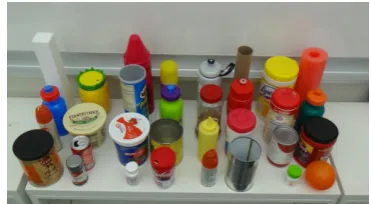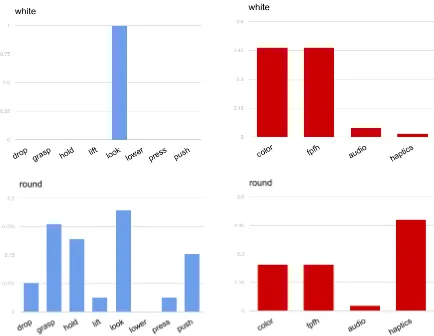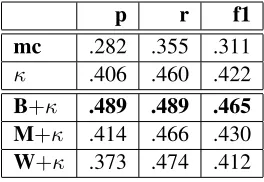Guiding Interaction Behaviors for
Multi-modal Grounded Language Learning
Jesse Thomason, Jivko Sinapov, and Raymond J. Mooney Department of Computer Science, University of Texas at Austin
Austin, TX 78712, USA
{jesse, jsinapov, mooney}@cs.utexas.edu
Abstract
Multi-modal grounded language learning connects language predicates to physical properties of objects in the world. Sensing with multiple modalities, such as audio, haptics, and visual colors and shapes while performing interaction behaviors like lift-ing, dropplift-ing, and looking on objects en-ables a robot to ground non-visual predi-cates like “empty” as well as visual pred-icates like “red”. Previous work has es-tablished that grounding in multi-modal space improves performance on object retrieval from human descriptions. In this work, we gather behavior annotations from humans and demonstrate that these improve language grounding performance by allowing a system to focus on relevant behaviors for words like “white” or “half-full” that can be understood by looking or lifting, respectively. We also explore adding modality annotations (whether to focus on audio or haptics when performing a behavior), which improves performance, and sharing information between linguis-tically related predicates (if “green” is a color, “white” is a color), which improves grounding recall but at the cost of preci-sion.
1 Introduction
Connecting human language predicates like “red” and “heavy” to machine perception is part of the
symbol grounding problem (Harnad, 1990), ap-proached in machine learning as grounded lan-guage learning. For many years, grounded lan-guage learning has been performed primarily in visual space (Roy and Pentland, 2002;Liu et al.,
2014;Malinowski and Fritz, 2014;Mohan et al.,
2013;Sun et al.,2013;Dindo and Zambuto,2010;
Vogel et al., 2010). Recently, researchers have explored grounding in audio (Kiela and Clark,
2015), haptic (Alomari et al., 2017), and multi-modal (Thomason et al., 2016) spaces. Multi-modal grounding allows a system to connect lan-guage predicates like “rattles”, “empty”, and “red” to their audio, haptic, and color signatures, respec-tively.
Past work has used human-robot interaction to gather language predicate labels for objects in the world (Parde et al.,2015;Thomason et al.,2016). Using only human-robot interaction to gather la-bels, a system needs to learn effectively from only a few examples. Gathering audio and haptic perceptual information requires doing more than looking at each object. In past work, multiple in-teraction behaviors are used to explore objects and add this audio and haptic information (Sinapov et al.,2014).
In this work, we gather annotations on what ex-ploratory behaviors humans would perform to de-termine whether language predicates apply to a novel object. A robot could gather such informa-tion by asking human users which acinforma-tion would best allow it to test a particular property, e.g. “To tell whether something is ‘heavy’ should I look at it or pick it up?” Figure1 shows some of the behaviors used by our robot in previous work to perceive objects and their properties. In this pa-per, we show that providing a language ground-ing system with behavior annotation information improves classification performance on whether predicates apply to objects, despite having sparse predicate-object labels.
We additionally explore adding modality anno-tations (e.g. is a predicate more auditory or more haptic), drawing on previous work in psychology that gathered modality norms for many words ( Ly-nott and Connell,2009). Finally, we explore using
grasp lift lower
[image:2.595.322.508.62.164.2]drop press push
Figure 1: Behaviors the robot used to explore ob-jects. In addition, thehold behavior (not shown) was performed after the lift behavior by holding the object in place for half a second. The look
behavior (not shown) was also performed for all objects.
word embeddings to help with infrequently seen predicates by sharing information with more com-mon ones (e.g. if “thin” is comcom-mon and “narrow” is rare, we can exploit the fact that they are lin-guistically related to help understand the latter).
2 Dataset and Methodology
Previous work provides sparse annotations of 32 household objects (Figure2) with language pred-icates derived during an interactive “I Spy” game with human users (Thomason et al.,2016). Each predicate p ∈ P from that work is associated with objects as applying or not applying, based on dialog with human users. For example, pred-icate “red” applies to several objects and not to others, but for many objects its label is not ex-plicitly known. Objects are represented by fea-tures gathered during several interaction behav-iors (Figure 1) as detailed in past work (Sinapov et al., 2016). In this work, we focus on improv-ing the language groundimprov-ing performance of multi-modal classifiers that predict whether each predi-catep∈P applies to each objecto∈O.
[image:2.595.69.299.65.247.2]In previous work, decisions about a predicate and an object are made for each sensorimotor con-text (a combination of a behavior and sensory modality) with an SVM using the feature space for that context (Thomason et al.,2016). A sum-mary of sensorimotor contexts is given in Table1.
Figure 2: Objects explored via interaction behav-iors and for which we have sparse predicate anno-tations.
Behaviors Modalities
look color, fpfh
drop, grasp, hold, lift
[image:2.595.326.509.228.286.2]lower, press, push audio, haptics Table 1: Thecontexts(combinations of robot be-havior and perceptual modality) we use for multi-modal language grounding. The color modality is color histograms, fpfh is fast-point feature his-tograms,audiois fast Fourier transform frequency bins, andhapticsis averages over robot arm joint forces (detailed in (Sinapov et al.,2016)).
For example, a classifier is trained from the pos-itive and negative object examples for “red” in
look/color space as well as in the less relevant
drop/audio space. These decisions are then av-eraged together, each weighted by its Cohen’s-κ agreement with human labels using leave-one-out cross validation on the training data. In this way, thelook/colorspace for “red” is expected to have highκand a large influence on the decision, while
drop/audiowould have lowκand not influence the decision much.
The decisiond(p, o) ∈ [−1,1] for predicatep and objectois defined as:
d(p, o) =X c∈C
κp,cGp,c(o), (1)
forGp,c a supervised grounding classifier trained on labeled objects for predicate p in the feature space of sensorimotor context c that returns in
{−1,1} with κp,c its agreement with human la-bels. Ifd(p, o)≤0, we saypdoes not apply too, else that it does. We use SVMs with linear kernels as grounding classifiers.
Figure 3: The distribution over annotator-chosen behaviors (left) gathered in this work, as well as the distribution over modality norms (right) de-rived from previous work (Lynott and Connell,
2009), for the predicates “white” and “round”. Thefpfhmodality is fast-point feature histograms.
in previous work, we gather relevant behaviors from human annotators. Annotators were asked to mark which among the 8 exploratory behav-iors (Table1) they would engage in to determine whether a given predicate applied to a novel ob-ject. Annotators could mark as many behaviors as they wanted for each predicate, but were required to choose at least one.
We gathered annotations from 14 people, then discarded the annotations from those whose av-erage κ agreement with all other annotators was less than0.4(the poor-fair agreement range). This left us with 8 annotators whose averageκ=.475 (moderate agreement). We release the full set of gathered annotations on 81 perceptual predi-cates across 8 behaviors as a corpus for commu-nity use.1
Then, for eachp ∈P, we induce a distribution over behaviors b ∈ B based on the ratio of an-notators that marked that behavior relevant, such thatPb∈BAB
p,b = 1, withABp,b equal to the pro-portion of annotators who marked behaviorb rel-evant for understanding predicatep. Some predi-cates, like “white”, have single behavior distribu-tions. For other predicates, like “metal”, annota-tors chose more complex combinations of behav-iors. Figure3 (Left) gives some examples of be-havior distributions from our annotations.
1http://jessethomason.com/publication_ supplements/robonlp_thomason_mooney_ behavior_annotations.csv
The decisiondB(p, o)considering behavior an-notations is calculated as
dB(p, o) =
X
c∈C
ABp,cbκp,cGp,c(o), (2)
wherecb is the behavior for sensorimotor context c.
We also experiment with adding modality an-notations (Table 1). In particular, we derive a modality distribution for each p ∈ P such that
P
m∈MAMp,m = 1 from modality exclusivity norms gathered by past work for auditory, gusta-tory, haptic, olfacgusta-tory, and visual modalities ( Ly-nott and Connell, 2009). We ignore gustatory and olfactory modalities, which have no counter-part in our sensorimotor contexts, and createAM
p,m scores from the auditory, haptic, and visual modal-ity norm means. The visual modalmodal-ity norm is split evenly between relevance scoresAM
p,colorand
AM
p,fpfh, our visual color and shape modalities.
The decisiondM(p, o)considering modality an-notations is calculated as
dM(p, o) =
X
c∈C AM
p,cbκp,cGp,c(o) (3)
When the predicatepdoes not appear in the norm-ing dataset from past work2, a uniform AM
p,m =
1/|M|is used. Figure3(Right) gives some exam-ples of modality distributions from these norms.
The data sparsity inherent in language ground-ing from limited human interaction means some predicates have just a handful of positive and negative examples, while more common predi-cates may have many. If we have few exam-ples for “narrow” but many for “thin,” we can share some information between them. For ex-ample, if κthin,grasp/haptic is high, we should trust
the grasp/haptic sensorimotor context for “nar-row” more than “nar“nar-row”sκ estimates alone sug-gest.
We explore sharing κ information between related predicates by calculating their cosine distance in word embedding space by using Word2Vec (Mikolov et al.,2013) vectors derived from Google News.3 For every pair of predicates
p, q ∈ P with word embedding vectorsvp, vq we calculate similarity as
w(p, q) = 12(1 +cos(vp, vq)), (4)
2About half the predicates have norming information. 3https://github.com/mmihaltz/
p r f1 mc .282 .355 .311 κ .406 .460 .422
B+κ .489 .489 .465 M+κ .414 .466 .430
[image:4.595.115.247.62.153.2]W+κ .373 .474 .412
Table 2: Precision (p), recall (r), and f1 (f1) of predicate classifiers across weighting schemes.
mc gives majority class baseline. Weighting schemes consider only validation confidence (κ, as in previous work), confidence and behavior an-notations (B+κ), confidence and modality anno-tations (M+κ), and confidence and word similar-ity (W+κ). Note that we show the average per-predicatef-measure, not thef-measure of the av-erage per-predicate precision and recall.
which falls in [0,1], and subsequently take a weighted average ofκvalues using these similari-ties as weights to get decisionsdW(p, o)as
dW(p, o) =X c∈C
|P|−1X
q∈P
κq,cw(p, q)
Gp,c(o)
(5)
3 Experimental Evaluation
We calculated precision, recall, andf-measure be-tween human labels and predicate decisions when weighting constituent sensorimotor context classi-fiers by the schemes described above: kappa confi-dence only (Eq1,κ), adding behavior annotations (Eq2,B+κ), adding modality annotations (Eq3,
M+κ), and sharing kappas across predicates using word similarity (Eq5,W+κ).
We calculated these metrics for each predicate4
and averaged scores across all predicates. We use leave-one-object-out cross validation to obtain performance statistics for each weighting scheme. Table2gives the results for predicates that have at least 3 positive and 3 negative training object examples.5
We observe that adding behavior annotations or modality annotations improves performance over 4Decisions were made for each testing object and marked
correct or incorrect against human labels that object, if avail-able for the predicate.
5The trends are similar when considering all predicates,
but the scores and differences in performance are lower due to many predicates having only a single positive or negative example.
using kappa confidence alone, as was done in past work. Sharing kappa confidences across similar predicates based on their embedding cosine simi-larity improves recall at the cost of precision.
Adding behavior annotations helps more than adding modality norms, but we gathered behav-ior annotations for all predicates, while modal-ity annotations were only available for a subset (about half). Adding behavior annotations helped thef-measure of predicates like “pink”, “green”, and “half-full”, while adding modality annotations helped with predicates like “round”, “white”, and “empty”.
Sharing confidences through word similarity helped with some predicates, like “round”, at the expense of domain-specific meanings of predi-cates like “water”. In the “I Spy” paradigm from which these data were gathered, the authors noted that “water” correlated with object weight because all of their water bottle objects were partially or completely full (Thomason et al.,2016). Thus, in that domain, “water” is synonymous with “heavy”. In a less restricted domain, word similarity may add less real world “noise” to the problem.
4 Conclusions and Future Work
In this work, we have demonstrated that behavior annotations can improve language grounding for a platform with multiple interaction behaviors and modalities. In the future, we would like to apply this intuition in an embodied dialog agent. If a per-son asks a service robot to “Get the white cup.”, the robot should be able to ask “What should I do to tell if something is ‘white’?”, a behavior an-notation prompt. A human-robot POMDP dialog policy could be learned, as in previous work ( Pad-makumar et al.,2017), to know when this kind of follow-up question is warranted.
Additionally, we will explore other methods of sharing information between predicates from lex-ical information. For example, choosing a maxi-mally similar neighboring word, rather than doing a weighted average across all known words, may yield better results (e.g. the best neighbor of “nar-row” is “thin”, so don’t bother considering things like “green” at all).
Acknowledgments
Fellowship to the first author, an NSF EAGER grant 1548567), and an NSF NRI grant (IIS-1637736). A portion of this work has taken place in the Learning Agents Research Group (LARG) at UT Austin. LARG research is supported in part by NSF (CNS-1330072, CNS-1305287, IIS-1637736, IIS-1651089), ONR (21C184-01), AFOSR (FA9550-14-1-0087), Raytheon, Toyota, AT&T, and Lockheed Martin.
References
Muhannad Alomari, Paul Duckworth, David C. Hogg, and Anthony G. Cohn. 2017. Natural language ac-quisition and grounding for embodied robotic sys-tems. InProceedings of the Thirty-First AAAI Con-ference on Artificial Intelligence. pages 4349–4356. Haris Dindo and Daniele Zambuto. 2010. A proba-bilistic approach to learning a visually grounded lan-guage model through human-robot interaction. In International Conference on Intelligent Robots and Systems. IEEE, Taipei, Taiwan, pages 760–796. S. Harnad. 1990. The symbol grounding problem.
Physica D42:335–346.
Douwe Kiela and Stephen Clark. 2015. Multi- and cross-modal semantics beyond vision: Grounding in auditory perception. In Proceedings of the 2015 Conference on Emperical Methods in Natural Lan-guage Processing. Lisbon, Portugal, pages 2461– 2470.
Changson Liu, Lanbo She, Rui Fang, and Joyce Y. Chai. 2014. Probabilistic labeling for efficient ref-erential grounding based on collaborative discourse. In Proceedings of the 52nd Annual Meeting of the Association for Computational Linguistics. Balti-more, Maryland, USA, pages 13–18.
Dermot Lynott and Louise Connell. 2009. Modality exclusivity norms for 423 object properties. Behav-ior Research Methods41(2):558–564.
Mateusz Malinowski and Mario Fritz. 2014. A multi-world approach to question answering about real-world scenes based on uncertain input. In Proceed-ings of the 28th Annual Conference on Neural In-formation Processing Systems. Montr´eal, Canada, pages 13–18.
Tomas Mikolov, Ilya Sutskever, Kai Chen, Greg Cor-rado, and Jeffrey Dean. 2013. Distributed represen-tations of words and phrases and their composition-ality. InProceedings of the 26th International Con-ference on Neural Information Processing Systems. Lake Tahoe, Nevada, pages 3111–3119.
Shiwali Mohan, Aaron H. Mininger, and John E. Laird. 2013. Towards an indexical model of situated language comprehension for real-world cognitive
agents. In Proceedings of the 2nd Annual Confer-ence on Advances in Cognitive Systems. Baltimore, Maryland, USA.
Aishwarya Padmakumar, Jesse Thomason, and Ray-mond J. Mooney. 2017. Integrated learning of dia-log strategies and semantic parsing. InProceedings of the 15th Conference of the European Chapter of the Association for Computational Linguistics. Va-lencia, Spain, pages 547–557.
Natalie Parde, Adam Hair, Michalis Papakostas, Konstantinos Tsiakas, Maria Dagioglou, Vangelis Karkaletsis, and Rodney D. Nielsen. 2015. Ground-ing the meanGround-ing of words through vision and inter-active gameplay. In Proceedings of the 24th Inter-national Joint Conference on Artificial Intelligence. Buenos Aires, Argentina, pages 1895–1901. Deb Roy and Alex Pentland. 2002. Learning words
from sights and sounds: a computational model. Cognitive Science26(1):113–146.
Jivko Sinapov, Priyanka Khante, Maxwell Svetlik, and Peter Stone. 2016. Learning to order objects using haptic and proprioceptive exploratory behaviors. In Proceedings of the 25th International Joint Confer-ence on Artificial IntelligConfer-ence.
Jivko Sinapov, Connor Schenck, and Alexander Stoytchev. 2014. Learning relational object cate-gories using behavioral exploration and multimodal perception. In IEEE International Conference on Robotics and Automation.
Yuyin Sun, Liefeng Bo, and Dieter Fox. 2013. At-tribute based object identification. InInternational Conference on Robotics and Automation. IEEE, Karlsruhe, Germany, pages 2096–2103.
Jesse Thomason, Jivko Sinapov, Maxwell Svetlik, Pe-ter Stone, and Raymond Mooney. 2016. Learn-ing multi-modal grounded lLearn-inguistic semantics by playing “I spy”. InProceedings of the 25th Inter-national Joint Conference on Artificial Intelligence. pages 3477–3483.


